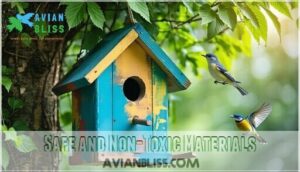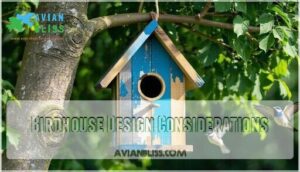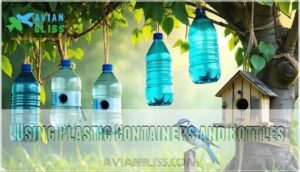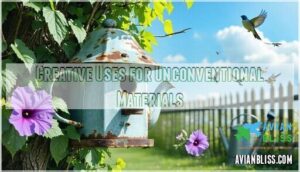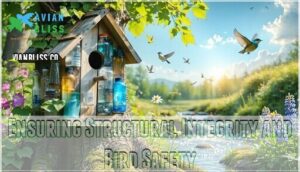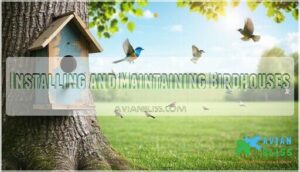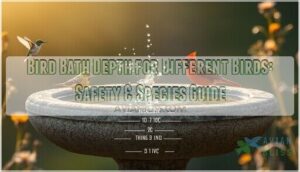This site is supported by our readers. We may earn a commission, at no cost to you, if you purchase through links.
 You’ll transform everyday waste into functional wildlife habitats when you create bird houses made from recycled materials.
You’ll transform everyday waste into functional wildlife habitats when you create bird houses made from recycled materials.
Plastic bottles, cardboard containers, and scrap wood become perfect building blocks for eco-friendly bird sanctuaries.
You’re not just reducing landfill waste—you’re providing essential nesting sites while teaching kids about conservation through hands-on creativity.
The process requires basic tools, weatherproof sealants, and attention to proper ventilation and drainage holes.
Choose materials carefully, avoiding toxic plastics or treated lumber that could harm feathered visitors.
Your recycled creations can match store-bought versions in durability and functionality while adding unique character to your garden space with personalized designs that reflect your commitment to environmental stewardship.
Table Of Contents
- Key Takeaways
- Benefits of Recycled Birdhouses
- Choosing Recycled Materials
- Birdhouse Design Considerations
- Upcycled Birdhouse Construction
- Installing and Maintaining Birdhouses
- Frequently Asked Questions (FAQs)
- How to make a recyclable birdhouse?
- What is one disadvantage of making plastic birdhouses?
- What are the best materials to make a bird shelter?
- What material is best for bird houses?
- What are birdhouses made of?
- How to make a birdhouse out of recycled materials?
- What is a recycled Birdhouse?
- Why should kids build birdhouses with recycled materials?
- Can you use rope to make a birdhouse?
- Can you use reclaimed wood for a birdhouse?
- Conclusion
Key Takeaways
- You’ll transform everyday waste like plastic bottles and cardboard into functional wildlife habitats while diverting materials from landfills
- You can create durable birdhouses that often outlast traditional wood construction using recycled plastics that resist weathering and cracking
- You’ll need to prioritize bird safety by choosing non-toxic materials, proper ventilation, drainage holes, and avoiding pressure-treated wood
- You can customize unique designs with recycled materials that commercial birdhouses can’t match while teaching kids about conservation through hands-on creativity
Benefits of Recycled Birdhouses
When you build birdhouses from recycled materials, you’re creating a win-win situation for both wildlife and the environment.
Build your recycled birdhouse and create a sustainable sanctuary that benefits both feathered friends and our planet.
You’ll reduce landfill waste while providing birds with safe, durable nesting spaces that often outlast traditional wood construction, plus you’ll discover creative design possibilities that conventional materials simply can’t match.
Ecological Benefits
When you build recycled bird houses, you’re creating a win-win situation for wildlife and the planet.
Habitat preservation becomes achievable as these sustainable bird homes provide essential nesting sites while reducing landfill waste.
Resource conservation happens naturally when you transform discarded materials into functional shelters.
Your carbon footprint shrinks substantially compared to purchasing new products, and eco-friendly materials like recycled plastics resist weathering better than traditional wood, creating long-lasting environmental conservation benefits, which support habitat preservation.
Unique Design Opportunities
With recycled materials as your canvas, you’ll discover design possibilities that commercial birdhouses simply can’t match.
These upcycled bird houses transform everyday waste into functional art, offering endless customization options for your backyard sanctuary.
Unique design opportunities with recycled materials:
- Artistic Expression – Paint old containers with vibrant, bird-safe colors that reflect your personality
- Innovative Features – Add creative perches using repurposed spoons or decorative elements from broken ceramics
- Material Combinations – Mix weathered wood with colorful plastic bottles for striking visual contrast
- Aesthetic Appeal – Create themed designs like rustic farmhouse or modern geometric patterns
- Customization Options – Adjust entrance holes and interior dimensions for specific bird species in your area
Consider incorporating proper ventilation and drainage to guarantee a healthy environment for nesting birds.
Reducing Waste and Conservation
Every recycled milk jug you transform into an ecofriendly birdhouse diverts waste from landfills while creating sustainable birding opportunities.
Every discarded container becomes a thriving bird sanctuary through your creative transformation efforts.
Your upcycled bird houses demonstrate conservation impact through habitat preservation, proving that birdhouse from recycled plastic construction reduces environmental footprint.
These eco-friendly habitats showcase how waste reduction and sustainability intersect perfectly with backyard wildlife support.
Choosing Recycled Materials
When you’re selecting recycled materials for your birdhouse, prioritize safety and durability above all else.
You’ll want to choose non-toxic, weather-resistant options while steering clear of pressure-treated wood that could harm our feathered friends, ensuring the use of non-toxic materials.
Safe and Non-Toxic Materials
Prioritizing bird safety means choosing materials free from harmful chemicals and toxins.
When selecting recycled plastic containers, look for HDPE or PET plastics that won’t cause chemical leaching into nesting areas.
Test paint safety by choosing water-based, low-VOC options over lead-based alternatives.
Natural alternatives like plant-based finishes offer ecofriendly solutions for waterproofing your birdhouse materials without compromising avian health.
Durable and Weather-Resistant Options
Once you’ve selected safe materials, your birdhouse needs to withstand nature’s challenges.
Recycled plastic delivers exceptional material longevity—lasting 50+ years while maintaining structural integrity. Weather protection comes naturally with UV-stabilized plastics that resist fading and cracking.
Here are three durable options for ecofriendly birdhouses:
- Recycled plastic lumber – Mimics wood appearance with superior birdhouse durability and minimal maintenance needs
- Birdhouse from recycled metal – Aluminum containers provide excellent weather resistance when properly sealed
- Birdhouse from recycled wood – Cedar or redwood scraps offer natural weather protection with proper treatment
Many retailers offer a recycled plastic option. Construction quality depends on selecting materials that handle temperature fluctuations without warping or deteriorating, ensuring your feathered friends stay comfortable year-round.
Avoiding Pressure-Treated Wood
When building ecofriendly birdhouses, you’ll want to steer clear of pressure-treated lumber.
Chemical concerns make these materials harmful to birds, as toxic preservatives can leach into Safe Habitats.
Natural alternatives like cedar offer excellent rot resistance without compromising bird health.
For material repurposing projects, untreated reclaimed wood provides wood longevity while supporting upcycling goals.
| Wood Type | Safety Level | Durability |
|---|---|---|
| Pressure-Treated | Toxic | High |
| Cedar | Safe | High |
| Pine (untreated) | Safe | Medium |
| Reclaimed Oak | Safe | High |
| Composite | Variable | High |
Birdhouse Design Considerations
When you’re building a birdhouse from recycled materials, proper design guarantees your feathered friends stay safe and comfortable year-round.
The right entrance hole size, adequate ventilation, and easy cleaning access make the difference between a functional home and an unused decoration.
Entrance Hole Size and Shape
Why does entrance hole size matter for your recycled birdhouse design? Getting it right means the difference between attracting your target bird species and inviting unwanted guests.
Here’s what you need to know about birdhouse entrance specifications:
- Size standards: Use 1.25-inch holes for chickadees and wrens, 1.5-inch for bluebirds and tree swallows
- Shape variety: Circular holes deter predators most effectively, while 85% of birds prefer round entrances
- Hole placement: Position 6-10 inches above floor, facing away from prevailing winds
- Predator baffle: Add metal guards to prevent hole enlargement and reduce predation by 50%
- Bird conservation: Proper sizing helps 70% of North American songbirds while deterring invasive species
DIY birdhouse ideas work best when your birdhouse entrance matches specific bird species requirements for ideal nesting success.
Ventilation and Drainage Essentials
Proper airflow design prevents deadly moisture buildup that can harm nestlings, while strategically placed drainage holes keep your recycled plastic birdhouse chamber dry and mold-free.
You’ll need ventilation gaps near the roof and drainage holes in the floor for effective moisture control and nestling safety during birdhouse maintenance seasons.
Insulation and Temperature Control
Temperature control challenges recycled plastic birdhouses since thin materials amplify heat, reaching dangerous 120°F on summer days.
You’ll need material insulation strategies: paint lighter colors for natural cooling, add ventilation design with small holes, and consider winter warmth through composite recycled panels.
Climate impact varies substantially – dense coconut shells or rice husk composites provide superior thermal regulation compared to single-layer plastics, supporting both environmental sustainability and birdhouse innovation.
Painting the exterior white can help with bluebird house cooling, which is a key factor in temperature control and birdhouse innovation for environmental benefits.
Easy Cleaning and Maintenance
In terms of ongoing upkeep, you’ll want your recycled bird houses designed with maintenance in mind.
Smart design choices now save you time and hassle later.
- Cleaning Frequency – Schedule annual deep cleans between nesting seasons
- Nest Removal – Install hinged panels or removable fronts for easy access
- Safe Products – Use mild soap solutions; avoid harsh chemicals on recycled plastic
- Pest Control – Design drainage holes to prevent moisture buildup and bacterial growth
- Repair Tips – Choose materials with natural bacteria resistance for longer-lasting homes
Upcycled Birdhouse Construction
You’ll find that transforming everyday discarded items into functional birdhouses gives new life to materials while creating safe nesting spaces for local birds.
This hands-on approach combines environmental responsibility with practical construction skills, turning plastic containers, scrap wood, and unexpected materials into weatherproof homes that birds actually want to use, providing them with a unique opportunity for practical construction.
Using Plastic Containers and Bottles
Converting plastic containers and bottles into bird houses transforms everyday waste into functional wildlife shelters.
You’ll need to prioritize plastic safety by selecting food-grade containers like milk jugs, ensuring proper container prep through thorough cleaning and smooth edge finishing.
Bottle birdhouses offer excellent plastic durability but face design limitations requiring careful entrance hole sizing and drainage modifications for successful ecofriendly crafts.
Many people also purchase pre-made options.
Working With Scrap Lumber and Wood
Beyond the workshop’s familiar corners, scrap lumber sourcing opens doors to handmade bird houses that breathe new life into forgotten wood.
You’ll discover ecofriendly crafts transform discarded materials into thriving bird habitat through creative reuse and safe woodworking practices. Many people enjoy building a scrap wood birdhouse as a fun project.
- Wood selection tips: Choose hardwoods like oak or cedar for durability, avoiding pressure-treated lumber
- Joint strength methods: Use wood glue with screws for weather-resistant connections in DIY projects
- Finishing scrap wood: Sand surfaces smooth, then apply natural sealers to protect your creation
Creative Uses for Unconventional Materials
Material sourcing takes an exciting turn with everyday treasures you might overlook.
Old teapots, boots, and watering cans transform into artistic birdhouses with unexpected textures.
Creative reuse of coffee cans and dried gourds offers eco-conscious design solutions.
These material combinations showcase environmental sustainability while delivering unique DIY birdhouses that stand out in your garden.
Consider using license plates as roofs for added flair, creating a truly unique DIY birdhouse.
Ensuring Structural Integrity and Bird Safety
When selecting recycled materials, you’re building more than shelter—you’re creating a fortress that’ll protect feathered families for years.
Test material strength by applying gentle pressure; quality recycled plastic should flex without cracking, ensuring joint stability against wind loads.
Install secure mounting points and overlapping joints to prevent predator access while maintaining proper drainage for weather resistance and ideal nesting safety throughout seasons.
Consider cedar’s natural rot-resistance for longevity.
Installing and Maintaining Birdhouses
Once you’ve built your recycled birdhouse, proper installation and ongoing maintenance guarantee it provides a safe, welcoming home for birds throughout the seasons.
Strategic placement and regular care keep your eco-friendly creation functioning effectively while protecting both the structure and its feathered residents, which is crucial for the birds’ well-being and the longevity of the birdhouse, making proper installation essential.
Choosing The Right Location
Once your recycled birdhouse is ready, strategic placement determines its success. Choose locations that balance Sun Exposure for warmth, Predator Avoidance through proper height, and Weather Protection from harsh elements.
These unique bird houses need careful positioning to create a birdfriendly garden.
- Mount 5-6 feet high on poles with baffles for backyard birding safety
- Face entrances away from prevailing winds and storms
- Select open areas with nearby shrubs matching Habitat Needs and natural habitats
- Certify Visibility for monitoring while maintaining quiet, low-traffic zones
Hanging and Securing The Birdhouse
Once you’ve found your perfect spot, proper birdhouse installation determines your project’s success.
Mount unique bird houses 4-8 feet high for most species, guaranteeing secure fasteners penetrate at least 2 inches into sturdy support structures.
| Mounting Method | Best For | Sway Reduction |
|---|---|---|
| Tree mounting | Natural look | Moderate flexibility |
| Post mounting | Open areas | Maximum stability |
| Pole systems | Predator deterrents | Adjustable height |
| Fence attachment | Limited space | Weather protection |
| Building mount | Urban settings | Minimal movement |
Install birdhouse designs with slight forward tilt for drainage while maintaining weather protection through overhanging roofs.
Position entrance holes away from prevailing winds, and guarantee birdhouse mounting hardware won’t rust or weaken over time.
Your recycled creation deserves birdhouse installation that’ll withstand seasons of backyard adventures.
Cleaning and Maintaining The Birdhouse
Regular cleaning keeps your birdhouse bacteria resistance strong and promotes bird health.
Clean annually after nesting season ends, removing old nests and debris with safe products like diluted bleach solution.
To prevent infestations, consider cleaning in September, which is after breeding season.
Inspect for repair needs while cleaning—check for cracks, loose screws, or pest control issues.
Choose birdhouse designs that are easy to clean with removable panels or hinged roofs for effortless nest removal and thorough cleaning frequency maintenance, ensuring a strong bird health.
Troubleshooting Common Issues
Moisture often sparks mold growth inside recycled birdhouses, creating health hazards for nesting birds.
Address drainage problems by drilling additional holes in the floor, and prevent mold with regular cleaning using diluted bleach solutions.
Check for birdhouse cracking, peeling, or chipping that allows water infiltration, and replace rotting sections immediately, and implement pest control measures like entrance hole guards to deter unwanted visitors during nest removal.
Frequently Asked Questions (FAQs)
How to make a recyclable birdhouse?
Picture yourself as nature’s architect, transforming everyday waste into a feathered friend’s sanctuary.
You’ll collect clean milk jugs, cereal boxes, or plastic bottles, then cut entrance holes, add ventilation, and secure weatherproof roofing for lasting durability.
What is one disadvantage of making plastic birdhouses?
Plastic birdhouses don’t breathe like wood does, so you’ll find moisture gets trapped inside, creating unhealthy conditions that can harm eggs and chicks with mold growth.
What are the best materials to make a bird shelter?
You’ll want cedar, redwood, or pine for wooden shelters since they resist weather and decay naturally. Recycled plastic offers excellent durability and won’t crack or fade over time.
What material is best for bird houses?
Cedar stands as your best choice, offering natural weather resistance and aromatic oils that deter insects.
You’ll find it lightweight yet durable, requiring minimal maintenance while providing excellent insulation for nesting birds year-round, with aromatic oils that enhance its utility.
What are birdhouses made of?
You’ll find birdhouses crafted from various materials including wood, recycled plastic, metal, and composite materials. Wood remains most popular, while recycled plastic offers durability and weather resistance without maintenance requirements.
How to make a birdhouse out of recycled materials?
Channeling ye olde craftsman’s ingenuity, you’ll transform everyday waste into feathered sanctuaries.
Collect plastic bottles, cardboard cartons, or wooden scraps, then cut entrance holes, drill drainage, and weatherproof your creation with non-toxic paint for lasting outdoor durability, utilizing your ingenuity to ensure a durable and safe habitat.
What is a recycled Birdhouse?
A recycled birdhouse is constructed from repurposed materials like plastic milk jugs, transforming waste into functional wildlife habitat.
You’ll find these eco-friendly alternatives offer durability while reducing environmental impact compared to traditional wooden designs, providing a functional wildlife habitat.
Why should kids build birdhouses with recycled materials?
Though you might think it’s just craft time, building recycled birdhouses teaches kids environmental responsibility while developing practical skills.
They’ll learn construction basics, reduce waste, and create wildlife habitats using everyday materials like plastic bottles or cardboard boxes, which helps in developing practical skills.
Can you use rope to make a birdhouse?
You can’t build a traditional wooden birdhouse using only rope, but you’ll create rope-wrapped structures or hanging rope nests.
Rope works better as accent material around wooden frames for texture and grip.
Can you use reclaimed wood for a birdhouse?
Yes, reclaimed wood works perfectly for birdhouses.
You’ll create a rustic haven that birds love while giving old lumber new purpose.
Just make certain it’s untreated, weathered naturally, and free from harmful chemicals or paint residues, to ensure a safe and rustic haven.
Conclusion
Picture vibrant gardens buzzing with life as rescued materials transform into welcoming homes for feathered neighbors.
Building bird houses made from recycled materials creates lasting environmental impact while fostering wildlife conservation in your backyard.
You’ve discovered how simple household items become functional sanctuaries that rival commercial alternatives.
Your commitment to sustainability now extends beyond waste reduction to active habitat creation.
These handcrafted structures demonstrate that environmental stewardship and practical functionality work together seamlessly, proving every recycled project makes a meaningful difference.
- https://www.fastercapital.com/start-a-tech-company.html?s=content
- https://nestwatch.org/learn/how-to-nestwatch/faqs/can-i-used-recycled-materials-to-build-a-nest-box/
- https://www.frontiersin.org/journals/built-environment/articles/10.3389/fbuil.2023.1271317/full
- https://swvawildlifecenter.org/2015/06/16/ventilated-recycled-birdhouse/
- https://www.reddit.com/r/birding/comments/wigqfm/would_it_be_bad_for_the_birds_if_i_build_a_bird/

